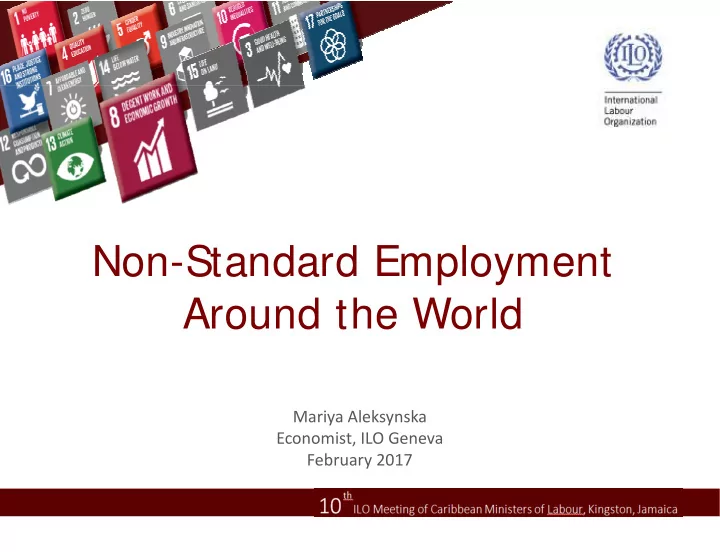

International Labour Organization Decent Work Team and Office for the Caribbean Non-Standard Employment Around the World Mariya Aleksynska Economist, ILO Geneva February 2017 th 10 ILO Meeting of Caribbean Ministers of Labour, Kingston, Jamaica
Content 1. What is non-standard employment? 2. Understanding trends in non-standard employment 3. Women, young people and migrants in non- standard employment 4. Why firms use non-standard employment and how it affects them 5. Effect on workers, labour markets and society 6. Addressing decent work deficits in non- standard employment
Defining Non-standard employment
Content 1. What is non-standard employment? 2. Understanding trends in non-standard employment 3. Women, young people and migrants in non- standard employment 4. Why firms use non-standard employment and how it affects them 5. Effect on workers, labour markets and society 6. Addressing decent work deficits in non- standard employment
Temporary employment 2004 2014 35.0 30.0 25.0 20.0 15.0 10.0 5.0 0.0 80.00 60.00 40.00 20.00 0.00
Part-time wage employment Less than 35 h a week MEN [0,10] (10,20] (20,30] (30,40] WOMEN (40,50] No data Belize, 2015: 9% [0,10] (10,20] (20,30] (30,40] Bermuda, 2010: 9,5% (40,50] No data
Multi-party employment relationship Largest markets: United States, China, Europe, and Japan Republic of Korea: “in-house subcontracting” - 55% of firms The Philippines: “agency-hired” workers - 62% of firms South Africa: in labour brokering - 6.5% of workforce Disguised / dependent self-employment Chile: 12–17 % of subcontracting firms Argentina: 2.3% of workers Mexico: 4.1% of workers US: 8 -13 per % of workers in construction Jamaica: “contractors”: private security guards, hotel and food industries Businesses in the “on-demand” or “gig” economy hire “independent contractors”
Reasons for Dynamics Regulation Macroeconomic Transformations in fluctuations and crisis the world of work Partial deregulation Adjustments through The rise of the decline in the use of service sector NSE Distorted incentives Pressure from Temporary reductions globalization in working hours Decline in Technological unionization and developments Increase in NSE due to the regulatory economic uncertainty Shifting role of collective organizational bargaining strategies
Content 1. What is non-standard employment? 2. Understanding trends in non-standard employment 3. Women, young people and migrants in non- standard employment 4. Why firms use non-standard employment and how it affects them 5. Effect on workers, labour markets and society 6. Addressing decent work deficits in non- standard employment
Who uses and why? Evidence on use of temporary labour 132 developing and transition countries 22 EU countries 6.8 7.2 Don't use 16.3 32.8 Regular use 60.0 77.0 Intensive use Cost-saving, flexibility, technology
Who uses and why? Evidence on use of temporary labour, textiles Don't use Regular use Intensive use 100 80 60 40 20 0
Average share of temporary workers in using firms Evidence on use of temporary labour, textiles 30 25 20 15 10 5 0 Source: World Bank Enterprises Survey
Implications for firms
Content 1. What is non-standard employment? 2. Understanding trends in non-standard employment 3. Women, young people and migrants in non- standard employment 4. Why firms use non-standard employment and how it affects them 5. Effect on workers, labour markets and society 6. Addressing decent work deficits in non- standard employment
Why workers engage? Sometimes voluntary Voluntary part-time: Brazil: 93%, Argentina, Peru: 75% Care Part-time in Europe, 2014 and other 27% of women, 4.2% of men responsibilities Education Temporary work in Europe, 2014 or entry into labour 25% of women, 24% of men market (probation) Sometimes involuntary 2007 2014 100.0 80.0 60.0 40.0 20.0 0.0 Involuntary temporary employment
Implications for workers Working conditions
Content 1. What is non-standard employment? 2. Understanding trends in non-standard employment 3. Women, young people and migrants in non- standard employment 4. Why firms use non-standard employment and how it affects them 5. Effect on workers, labour markets and society 6. Addressing decent work deficits in non- standard employment
Making jobs better
Making jobs better
Policies to support workers
Thank you! Report and data are available at: http://www.ilo.org/global/topics/employment-security/non- standard-employment/lang--en/index.htm
Recommend
More recommend